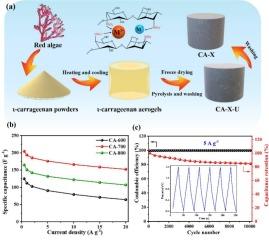Novel sulfur-doped hierarchical porous carbon from marine biomass for high-performance supercapacitor
IF 5.1
3区 材料科学
Q2 MATERIALS SCIENCE, COATINGS & FILMS
引用次数: 0
Abstract
Although hierarchical porous carbon materials are known for their excellent rate capability, they often suffer from low energy density in supercapacitors. Here, we present a novel approach to synthesizing hierarchical micro-mesoporous, sulfur-doped carbon derived from carrageenan biomass, which is being evaluated as a supercapacitor electrode material. The CA material is characterized by a high sulfur content (2.7 at. %), primarily in the form of sulfur-functionalized C-S-C bonds, alongside a variety of oxidized sulfur species. The ideal porous structure, with a micropore ratio of 63 %, is the result of the unique cation-induced self-assembly of carrageenan. The CA material exhibits an impressive specific capacitance of 204 F g−1 and higher capacitance retention rates of 74.5 % in a three-electrode configuration. When assembled into a symmetric supercapacitor, it delivers an exceptionally high energy density of 16.6 Wh kg−1 at 199 W kg−1 in a 1 M Na2SO4 aqueous electrolyte. These values exceed those of most previously reported hierarchical porous and heteroatom-doped carbon materials. This study presents a green, scalable synthesis route for producing sulfur-doped, hierarchical, porous carbon materials. The method uses the intrinsic -OSO3− groups and metal ions in carrageenan to enable in situ sulfur doping and self-templated pore formation. This avoids the need for toxic sulfur-containing precursors or gases, which are typically required in conventional approaches. The resulting material exhibits promising potential for application in high-performance, industrial-scale supercapacitors.

用于高性能超级电容器的新型海洋生物质硫掺杂分层多孔碳
虽然分层多孔碳材料以其优异的速率性能而闻名,但它们在超级电容器中往往存在能量密度低的问题。在这里,我们提出了一种新的方法来合成层次微介孔,硫掺杂碳从卡拉胶生物质衍生,正在评估作为超级电容器电极材料。CA材料具有高硫含量(2.7 at)的特点。%),主要以硫功能化的C-S-C键的形式,以及各种氧化硫物种。理想的多孔结构是卡拉胶独特的阳离子诱导自组装的结果,其微孔比为63%。在三电极结构下,CA材料表现出令人印象深刻的204 F g−1比电容和74.5%的高电容保持率。当组装成对称超级电容器时,在1m Na2SO4水溶液中,它在199 W kg - 1时提供了16.6 Wh kg - 1的超高能量密度。这些值超过了大多数先前报道的分层多孔和杂原子掺杂碳材料。本研究提出了一种绿色、可扩展的合成路线,用于生产硫掺杂、分层、多孔碳材料。该方法利用卡拉胶中固有的-OSO3 -基团和金属离子来实现原位硫掺杂和自模板孔的形成。这避免了需要有毒的含硫前体或气体,而传统方法通常需要这些前体或气体。所得到的材料在高性能、工业规模的超级电容器中显示出巨大的应用潜力。
本文章由计算机程序翻译,如有差异,请以英文原文为准。
求助全文
约1分钟内获得全文
求助全文
来源期刊

Diamond and Related Materials
工程技术-材料科学:综合
CiteScore
6.00
自引率
14.60%
发文量
702
审稿时长
2.1 months
期刊介绍:
DRM is a leading international journal that publishes new fundamental and applied research on all forms of diamond, the integration of diamond with other advanced materials and development of technologies exploiting diamond. The synthesis, characterization and processing of single crystal diamond, polycrystalline films, nanodiamond powders and heterostructures with other advanced materials are encouraged topics for technical and review articles. In addition to diamond, the journal publishes manuscripts on the synthesis, characterization and application of other related materials including diamond-like carbons, carbon nanotubes, graphene, and boron and carbon nitrides. Articles are sought on the chemical functionalization of diamond and related materials as well as their use in electrochemistry, energy storage and conversion, chemical and biological sensing, imaging, thermal management, photonic and quantum applications, electron emission and electronic devices.
The International Conference on Diamond and Carbon Materials has evolved into the largest and most well attended forum in the field of diamond, providing a forum to showcase the latest results in the science and technology of diamond and other carbon materials such as carbon nanotubes, graphene, and diamond-like carbon. Run annually in association with Diamond and Related Materials the conference provides junior and established researchers the opportunity to exchange the latest results ranging from fundamental physical and chemical concepts to applied research focusing on the next generation carbon-based devices.
 求助内容:
求助内容: 应助结果提醒方式:
应助结果提醒方式:


